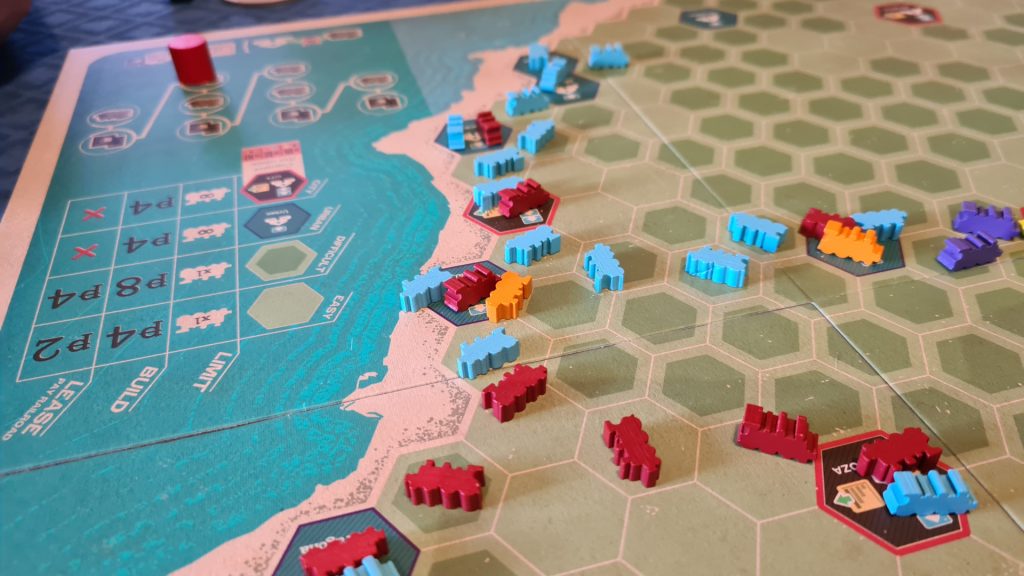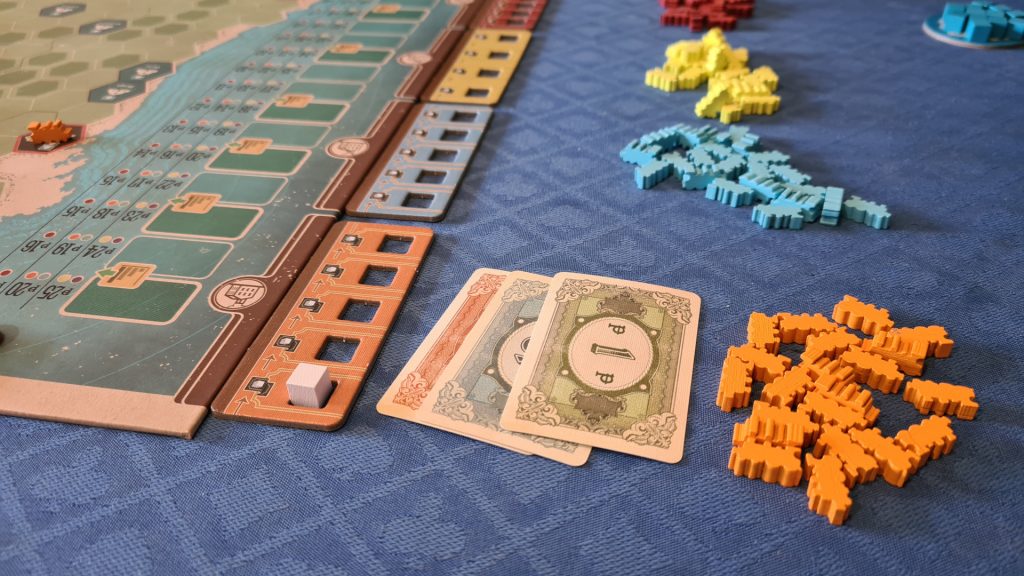Iberian Gauge is the third of three Iron Rail titles from publisher Capstone Games, featuring stocks, train networks and hopefully large profits. Designed by Amabel Holland, featuring artwork from Ian O’Toole, the game sees 3 – 5 players investing in train companies, expanding the train routes across Spain and Portugal and causing stocks to rise and fall. Playing in around an hour, is this the economic train game for you? Let’s find out!
Players each start with 40 pesetas and a pile of their chosen colour’s cubes. With the main board in the middle of the table, the 5 train company tiles are randomly placed alongside it, with the associated 22 trains of each company. Played out over 10 rounds, there are 4 rounds to purchase stocks and 6 building rounds. Starting with a stock phase, this sees players given the chance to spend their money. Going clockwise around the table, on a player’s turn they can choose to either invest in a new train company or if there are already train companies established invest in them.
If it’s a new train company, as in no stocks had previously been bought, the player chooses what stock price to set the train company to – between 12 and 36 pesetas. Importantly, the money paid goes to that train company’s treasury and not that bank. When buying a stock the company must have an available stock to sell, indicated by an empty slot on its board – where the player adds one of their cubes.
At this point the player chooses the starting city for the train company, placing a train of that company’s colour onto any empty major city on the board. The train company’s dividend token is also then placed at the bottom of the tracker. If instead the player chooses to invest in an already in-play company, they simply would pay the current stock price into the train company’s treasury.
This phase can play out completely differently, depending on how high or low stock prices are set. In later rounds there’s also the drive to get stocks in companies that weren’t performing well with fallen stock prices, whilst riding the coattails of their successful company dividends. If a player wants to or cannot afford any stocks they can pass. Starting a round of everyone passing sees the first passer claiming the priority marker for the next stock phase.

After each stock phase there are either 1 or 2 build phases. Working from the top of the train company tiles in order, for each player cube that player gets the opportunity to build a single piece of track. This sees the player take one of the available trains and add it to the board, often adjacent to a hexagon with that company’s train in it. Apart from in urban and city locations only one train company can occupy a space, the cost based on the terrain type. Players can instead lease tracks from other companies to effectively skip over occupied spaces.
When leasing the money for the track goes to the respective company’s treasury, with any other money spent going to the bank. Importantly, none of this money can come from players. It must come from the treasury of the train company, which can run out! Whenever a new urban hexagon is connected it drives the dividend token up one space on the track, which can cause the train company’s stock to rise. Connecting to a major city sees the dividend increase twice and the stock price rise, and there’s even a bonus dividend payout for a company linking 5 major cities.
Once every stock cube on a train company’s tile has either built or passed, it is then time for dividends and to check if new connections have been made. Note, if a player has more than one stock cube in a company they can build a track for each of their cubes, still following the investment order. Dividends are paid from the bank per stock cube a player has in that company, based on the dividend tracker. The train company gets the money from unowned stocks, which is added to the company’s treasury.
If a connection to an urban or city hex hasn’t been made then the train company’s stock price drops, per stock owned by players – which can be by up to 6 times. If at least one urban or major city has been connected this penalty is avoided. This process happens for all of the train companies in play, individually but in order, before moving onto the next round. At the end of the tenth round players gain the monetary value of their stocks. Combining this with money they gained throughout the game and the winner is whoever has the most pesetas.
Iberian Gauge’s rulebook is 2 sides of A4 and this really does represent the entirety of the rules. There’s no questions left unanswered and the font isn’t tiny. Despite this short ruleset, the game isn’t a simple family friendly game. On top of getting particularly mean at times, there’s the understanding needed to see the flow of money. From stocks, wasting a train company’s money via bad track builds, dividends and such to get a grip on. Still, the rules are short and let the interaction between players and stocks be where the game sings.

There are some occasions when there isn’t really much of a choice. If all other players are invested in a train company and it’s cheap then it’s often worth buying a stock if possible. Also if there’s one stock left it is rare for players to skip over the option to buy the last stock. This seems to be exacerbated in a five player game where almost all of the stocks may have sold by the end of the 3rd stock phase. If stocks are set cheap as they were in one playthrough it meant only a single stock was left unpurchased going into the final stock phase, though this wouldn’t be as noticeable an issue at 3 – 4 players.
Early on in Iberian Gauge the stock value penalty seems fair, often only moving down if there’s a single stock purchased in the company, as they potentially cannot build enough to get to an urban area or another city. At the end of the game there can be huge swings in stock price. It feels very mean to waste the money of a company on a pointless hexagon for players doubling invested to lose a good 20 pesetas per stock. It’s a stock game and these massive gains and losses are part of the experience but it’s not a great feeling to be on either side of a stock price tumble.
When it comes to the production quality, Iberian Gauge does a good job. Compared to 18XX style stock train games the board looks relatively nice, being extremely readable. Compared to many other board games though it is crying out for some extra details, even hints of terrain. Initially the train pieces did seem on the small side, though this is to accommodate the cities where all 5 train companies can be at once.
One odd choice, which thankfully hasn’t tripped anyone up yet, is that there is a blue player colour and a blue train company. These are different blues but still are a little close for my liking. For the most part the money decks do well. Though, at the start of the game more 1 pesetas cards would have made things easier and by the end we were surprised by the jump between 20 and 100. The 100 pesetas deck is also huge in comparison to what was needed.
With short rules Iberian Gauge rather quickly hits the table and then players truly start to learn how to play. When to invest and buy a stock in a company is an important choice and one all players will grapple with throughout the experience, at least at lower player counts. There’s no getting past the possibility of meanness when it comes to crashing the stock of a company someone else has heavily invested in. Still, there’s also chances to drive that money into company’s you personally have interest in. Iberian Gauge won’t click with every group as a result, though for those it does, it’ll continue to hit the table for years to come!
(Editor’s Note: Iberian Gauge was provided to us by Asmodee for the review. The game is currently available from local board game stores! Find your local store here.)

